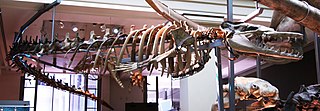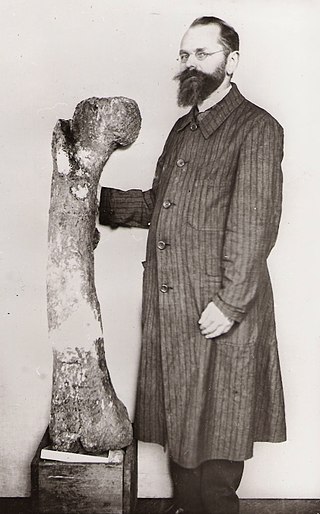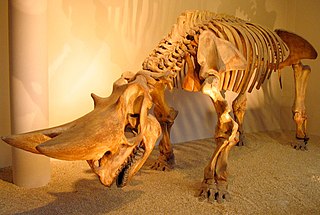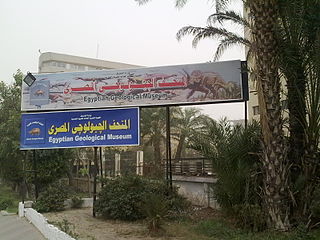Egypt has many fossil-bearing geologic formations, in which many dinosaurs have been discovered.
Egypt has many fossil-bearing geologic formations, in which many dinosaurs have been discovered.
Fayoum, Petrified wood protectorate in New-Cairo Area/ Cairo-Suez desert road & entire Western Desert of Egypt is covered in Petrified wood.
This is one of the clues that the region was a tropical climate. The petrified wood is very diverse and many samples are very beautiful, often actually littering the ground in certain areas.
The area of Uganda bordering Lake Victoria and the upper Nile River area is not unlike the climate of the Fayoum long ago, where many bird fossils have been discovered.
The Fayoum primates

Moeritherium is an extinct genus of primitive proboscideans. These prehistoric mammals are related to the elephant and, more distantly, sea cows and hyraxes. They lived during the Eocene epoch.

Basilosaurus is a genus of large, predatory, prehistoric archaeocete whale from the late Eocene, approximately 41.3 to 33.9 million years ago (mya). First described in 1834, it was the first archaeocete and prehistoric whale known to science. Fossils attributed to the type species B. cetoides were discovered in the United States. They were originally thought to be of a giant reptile, hence the suffix "-saurus", Ancient Greek for "lizard". The animal was later found to be an early marine mammal, which prompted attempts at renaming the creature, which failed as the rules of zoological nomenclature dictate using the original name given. Fossils were later found of the second species, B. isis, in 1904 in Egypt, Western Sahara, Morocco, Jordan, Tunisia, and Pakistan. Fossils have also been unearthed in the southeastern United States and Peru.

Ernst Freiherr Stromer von Reichenbach was a German paleontologist. He is best remembered for his expedition to Egypt, during which the first known remains of Spinosaurus were discovered.

Basilosauridae is a family of extinct cetaceans. They lived during the middle to the early late Eocene and are known from all continents, including Antarctica. They were probably the first fully aquatic cetaceans. The group is noted to be a paraphyletic assemblage of stem group whales from which the monophyletic Neoceti are derived.

Arsinoitherium is an extinct genus of paenungulate mammals belonging to the extinct order Embrithopoda. It is related to elephants, sirenians, hyraxes and the extinct desmostylians. Arsinoitheres were superficially rhinoceros-like herbivores that lived during the Late Eocene and the Early Oligocene of North Africa from 36 to 30 million years ago, in areas of tropical rainforest and at the margin of mangrove swamps. A species described in 2004, A. giganteum, lived in Ethiopia about 27 million years ago.

Wādī al-Ḥītān is a paleontological site in the Faiyum Governorate of Egypt, some 150 kilometres (93 mi) south-west of Cairo. It was designated a UNESCO World Heritage Site in July 2005 for its hundreds of fossils of some of the earliest forms of whale, the archaeoceti. The site reveals evidence for the explanation of one of the greatest mysteries of the evolution of whales: the emergence of the whale as an ocean-going mammal from a previous life as a land-based animal. No other place in the world yields the number, concentration and quality of such fossils, nor their accessibility and setting in an attractive and protected landscape. The valley was therefore inscribed on the UNESCO World Heritage List in 2005.

Faiyum is a city in Middle Egypt. Located 100 kilometres southwest of Cairo, in the Faiyum Oasis, it is the capital of the modern Faiyum Governorate. Originally called Shedet in Egyptian, the Greeks called it in Koinē Greek: Κροκοδειλόπολις, romanized: Krokodilópolis, and later Medieval Greek: Ἀρσινόη, romanized: Arsinoë. It is one of Egypt's oldest cities due to its strategic location.
The genus Apidium is that of at least three extinct primates living in the early Oligocene, from 30 to 28 million years ago. Apidium fossils are common in the Fayoum deposits of Egypt. Fossils of the earlier species, Apidium moustafai, are rare; fossils of the later species Apidium phiomense are fairly common.

The Egyptian Geological Museum is a museum in Cairo, Egypt. The museum was established in 1901 as part of the Egyptian Geological Survey, which had been started in 1896 under the direction of the Khedive Ismail. The museum was the first of its kind in the Middle East and the African continent.
Eogavialis is an extinct genus of eusuchian crocodylomorph, usually regarded as a gavialoid crocodylian. It superficially resembles Tomistoma schlegelii, the extant false gharial, and consequently material from the genus was originally referred to Tomistoma. Indeed, it was not until 1982 that the name Eogavialis was constructed after it was realised that the specimens were from a more basal form.

The Jebel Qatrani Formation is a geologic formation located in the Faiyum Governorate of central Egypt. It is exposed between the Jebel Qatrani escarpment and the Qasr el Sagha escarpment, north of Birket Qarun lake near Faiyum. The formation conformably overlies the Qasr el Sagha Formation and is topped by the Widan el Faras Basalt. The age of the formation has been subject to debate, but the most recent research indicates that it covers both the latest parts of the Eocene and the Early Oligocene, spanning over the boundary between these two time periods.
The Qasr el Sagha Formation is a geological formation located in Egypt. The formation is part of the Wadi El Hitan World Heritage Site. The Qasr el Sagha Formation overlies the Birket Qarun Formation and is overlain by the Gebel Qatrani Formation. The sandstones and shales of the formation were deposited in a deltaic to shallow marine environment. It dates to the Late Eocene.

Wadi El Rayan is a unique nature protectorate in Faiyum Governorate, Egypt, under the supervision of the Ministry of Environmental Affairs (EEAA).
Pontogeneus is a genus of extinct cetacean known from fossils recovered from Late Eocene sediments of the southeastern United States.

Saghacetus is an extinct genus of basilosaurid early whale, fossils of which have been found in the Upper Eocene Qasr el Sagha Formation, Egypt.
Cordichelys is an extinct genus of podocnemidid turtle. It was around during the Eocene. Fossils of this turtle have been discovered at Wadi El Hitan as of November 2020.

Stromerius is an extinct genus of basilosaurid early whale known from the Late Eocene of Fayum, Egypt.

Hesham Sallam is an Egyptian paleontologist and the founder of the Mansoura University Vertebrate Paleontology Center (MUVP-C), the first vertebrate paleontology program in the Middle East. He works as an associate professor at the American University in Cairo and Mansoura University. Sallam led the discovery and description of Mansourasaurus shahinae, a species of sauropod dinosaur from Egypt, which has improved understanding of the prehistory of Africa during the latest Cretaceous period. His work has helped popularize paleontology in Egypt.

Eopelecanus is an extinct genus of pelican from the Birket Qarun Formation in the Wadi El Hitan in Egypt, dating to the late Eocene (Priabonian). The holotype, a right tibiotarsus discovered in 2008, represents the oldest record of pelicans to date, the only named fossil pelican to date and only one species is known, E. aegyptiacus.